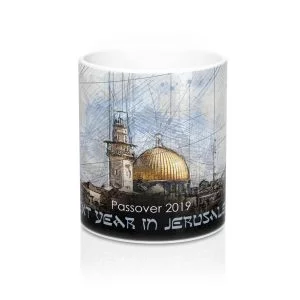The Seder Plate – A Beautiful Artifact of the Jewish Passover
Creating the Perfect Passover Seder Plate
Traditionally, the Seder plate is presented at Passover and includes the symbolic foods to commemorate the Jewish holiday. Here are some easy tips for making a gorgeous Passover Seder plate that respects tradition and satisfies guests.
What Is the Passover Seder?
A good place to start is understanding the symbolic importance of the Passover Seder. The word “Seder” translates to “order” or “arrangement” in Hebrew, and refers to the way the foods are presented at the start of the Passover holiday.
The holiday lasts for eight days, but the Seder marks the beginning of Passover. This is when groups get together and retell the story of the Israelite's freedom from the ancient Egyptians.
Hebrew Scriptures command Jews to tell this story to future generations, and so the Seder is very important. Part of this ritual involves eating specific foods, and this Seder meal symbolism is passed down through families.
The Seder Plate
The Passover Seder plate is extremely important to Jewish families. It is a special platter saved for this specific holiday. Six food items are placed on this plate, each with its own significance in the story of the Israelites' exodus out of Egypt.
The First Food of the Passover Seder Plate: Karpas
The six foods that make up the Seder plate arrangement each have their own symbology. First, is the Karpas, which serves as the appetizer. This is a vegetable such as potato, onion, or celery. Participants dip the vegetable into salt water or vinegar. This represents the tears that were shed by their Jewish ancestors.
The Second Food of the Passover Seder Plate: Maror
Next is Maror, or bitter herbs. A blessing is said over the herbs before they are eaten. The most common herb that people use at Seder is grated horseradish root. The bitterness is meant to symbolize the bitterness and anger of the Egyptian’s rule over the Jews.
The Third Food of the Passover Seder Plate: Beitzah
Then, it’s time for the Beitzah, a roasted or charred egg. It has been boiled and then roasted in oil or lamb fat. This symbolizes the festival sacrifice in the Temple of Jerusalem back in ancient times.
The Fourth Food of the Passover Seder Plate: Charoset
The Charoset is a mixture of fruit and nuts that is ground into a thick, sweet paste. It represents the mortar that the ancient Jews used to build storehouses in Egypt.
The Fifth Food of the Passover Seder Plate: Zeroa
The Zeroa is roasted lamb bone or goat bone, which represents the Pesach sacrifice. It is eaten as part of the Seder meal.
The Sixth Food of the Passover Seder Plate: Chazeret
The Chazeret is romaine lettuce or another bitter green, such as endive, dandelion greens, or celery leaves.
The Seventh Food of the Passover Seder Plate:
Matzo (or Matza/Matzah) is unleavened bread that holds a special place in Passover Seder meal recipes. During the Passover, Jews are not permitted to consume chametz, or leavened bread products. Hence, the matzo. This unleavened flatbread has its own place on the Seder table, representing a seventh sacred food item. Traditionally, three matzo are placed on the table on their own plate. Each matzo is eaten at a specified time during the meal.
Seder Meal Symbolism
The Seder meal symbolism is extremely important to Jewish families, and the matzo has its own place in the meal. Throughout the meal, the matzo sits under a cloth napkin. After eating the karpas, the middle matzo is broken in half. The larger piece is saved for later, while the smaller piece is put back between the two other matzo. After reading the story of the Jewish exodus, the matzo are uncovered. Blessings are said before the matzo may be eaten.
What makes matzo so crucial to the Passover is that during the Jewish exodus, there was no time to wait for the bread to rise. Therefore, the Jews had to eat unleavened bread. Modern-day Jews observe this by refusing to eat leavened bread while commemorating the Passover.
Preparing the Passover Foods
While each family differs slightly on how they prepare the Passover foods, here are some Passover Seder meal recipes for getting started. Keep in mind that it takes quite a bit of time to prepare the meal, so cooking ahead of time is an excellent idea. These days, many families purchase matzo from the grocery store, and this is seen as acceptable to most Jews.
Preparing the Zeroa
As for the zeroa, many people choose to use a lamb bone, with the forearm being very popular. It should be roasted over an open flame on the stovetop. Some families may use goat or chicken, and it often depends on what is available in that particular part of the world.
Preparing the Beitzah, Maror and Chazeret
The beitzah is typically a simple hard-boiled egg. There should be one for each Seder plate. The maror (bitter herbs) are placed on top of the chazeret (romaine lettuce). Many Passover Seder meal recipes call for peeled and grated horseradish root. It’s important to note that this should be done before the actual holiday begins. The lettuce should be rinsed, cleaned, and thoroughly dried before making its way to the Seder plate
Reciting the Haggadah
During the meal, the family recites the story of the Jewish exodus (Haggadah) and then does the ritual hand-washing. Then, they eat matzo, maror, and a sandwich of matzo and maror, in that particular order.
Variations of charoset.
There are many different variations of charoset. Some mixtures include apples, pears, walnuts, and wine; others involve dates, almonds, walnuts, and red wine. Other varieties include fruits such as pomegranates, raisins, oranges, and bananas, as well as pistachios and a combination of spices such as cinnamon, nutmeg, and cayenne. Clearly, there are many ways to prepare charoset. At the Seder table, participants dip some maror into the charoset.
The Karpas Variations
For the karpas, lots of people use a raw onion or boiled potato. It is sliced and placed on the Seder plate. After saying the kiddush (blessing) and ritual handwashing, the karpas is dipped into salt water or vinegar. Each person at the table eats just a bit of this, about a ½ ounce.
Every Jewish family has its own way - Enjoy the Passover dear Jewish friends
These are just the basics of a traditional Seder plate, but it provides a better idea of how the traditional Passover is commemorated. Each family will have their own special way of preparing the foods, but all Jews appreciate the symbolism of this holiday.


